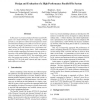105
Voted
LCN
2005
IEEE
15 years 6 months ago
2005
IEEE
In this paper we propose a high performance parallel file system over iSCSI (iPVFS) for cluster computing. iPVFS provides a cost-effective solution for heterogeneous cluster envi...
131
Voted
IPPS
2005
IEEE
15 years 6 months ago
2005
IEEE
Large-scale scientific computing applications frequently make use of closely-coupled distributed parallel components. The performance of such scientific applications is therefore ...
IPPS
2005
IEEE
15 years 6 months ago
2005
IEEE
High-performance computing is and has always been performance oriented. However, a consequence of the push towards maximum performance is increased energy consumption, especially ...
86
Voted
IPPS
2005
IEEE
15 years 6 months ago
2005
IEEE
This paper describes an overview of Environment for Memory Performance Studies (EMPS). EMPS is a framework to allow different data gathering and simulation tools to be composed to...
105
click to vote
IPPS
2005
IEEE
15 years 6 months ago
2005
IEEE
In 2002, Japan announced the Earth Simulator—a supercomputer based on low-volume vector processors and a custom network—and reported that computational scientists had used it ...
113
Voted
IEEECIT
2005
IEEE
15 years 6 months ago
2005
IEEE
In embedded systems, performance and power are important inter-related issues that cannot be decoupled. Expensive and extensive simulations in a processor design space are usually...
93
Voted
IEEECIT
2005
IEEE
15 years 6 months ago
2005
IEEE
Measurements are very useful to gauge the actual performance of various architectures and their components. In this paper we investigate the performance of the LAMP(Linux, Apache,...
101
click to vote
ICPP
2005
IEEE
15 years 6 months ago
2005
IEEE
Empirical performance evaluation of parallel systems and applications can generate significant amounts of performance data and analysis results from multiple experiments as perfo...
102
click to vote
HOTI
2005
IEEE
15 years 6 months ago
2005
IEEE
Modern routers and switch fabrics can have hundreds of input and output ports running at up to 10 Gb/s; 40 Gb/s systems are starting to appear. At these rates, the performance of ...
83
Voted
DATE
2005
IEEE
15 years 6 months ago
2005
IEEE
In this paper, we present a two-level modeling approach to performance macromodeling based on radial basis function Support Vector Machine (SVM). The two-level model consists of a...




